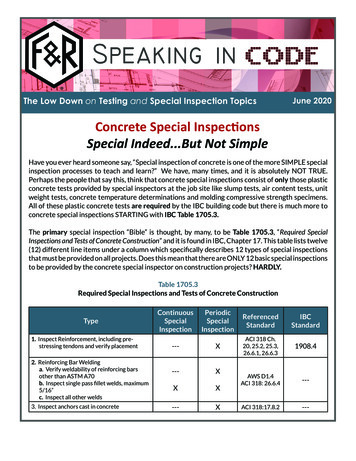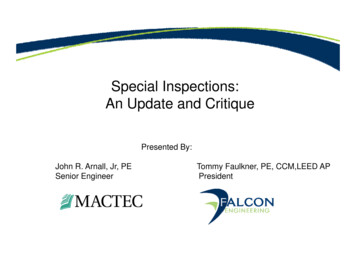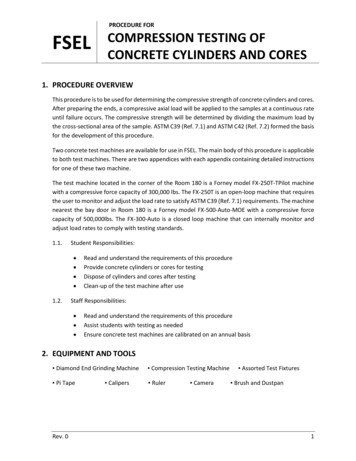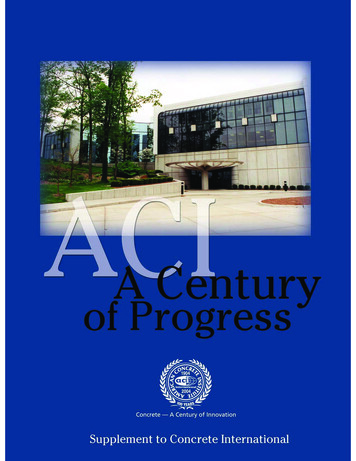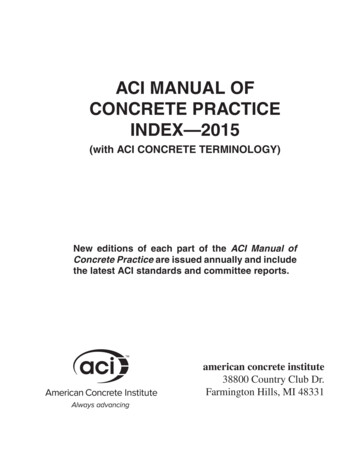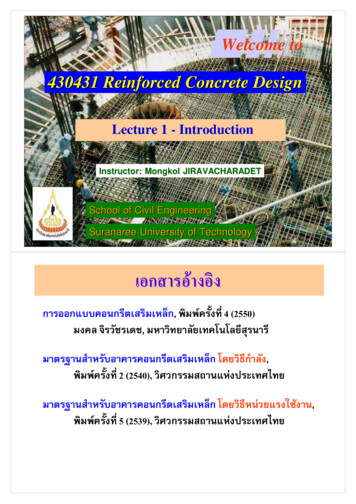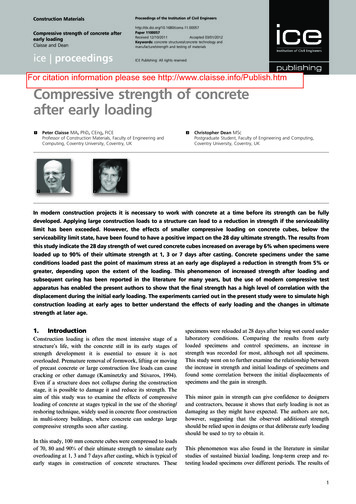
Transcription
UNIT 5SPECIAL CONCRETELight weight concrete - High density concrete - Self compacting concrete - High pressureconcrete - No fines concrete - Hot weather concreting, Under water converting - Vacuumconcrete - Ferro cement - Polymer concrete, High strength and High performance concrete Shotcrete process - Geopolymer concrete.LIGHT WEIGHT CONCRETELight weight concrete (foamed concrete) is a versatile material which consists primarilyof a cement based mortar mixed with at least 20% of volume air. The material is now being usedin an ever increasing number of applications, ranging from one step house casting to low densityvoid fills. Light weight concrete is a special concrete which weighs lighter than conventionalconcrete. The density of this concrete is considerably low (300 kg/m3 to 1850 kg/m3) whencompared to normal concrete (2200kg/m3 to 2600kg/m3).Three types of LWC Light weight aggregate concrete - UK, France & USA Aerated concrete - Scandinavian countries No – fines concrete is less popularLightweight and free flowing, it is a material suitable for a wide range of purposes suchas, but not limited to panels and block production, floor and roof screeds, wall casting, completehouse casting, sound barrier walls, floating homes, void infill, slope protection, outdoor furnitureand many more applications.Lightweight Concrete
Structural light weight concrete Concrete which is light weight and has sufficient compressive strength. 28 days compressive strength of more than 17Mpa and 28 days dry density not exceeding1850 kg/m3. Generally have normal fine aggregates and lighter coarse aggregates. Workability is less due to water absorption by the aggregates. Drying shrinkage is more and less thermal expansion than normal concrete. Is good in sound proofing, sound absorption & thermal insulation. Economical when compared to normal weight concrete. Has good fire resistance property than conventional concrete.Case study for LWC
Mix design of LWC Difficult to decide water – cement ratio, due to variable water absorption by aggregates. Generally done by trial mixing. Pre – saturation of aggregates is done to avoid excessive absorption of water byaggregates. Concrete with saturated aggregates will have higher density, which is bad in freezing &thawing action. In rare cases, aggregates are coated with bitumen to overcome the water absorptionproblem.NO-FINES CONCRETE It is a type of light weight concrete produced by omitting the fine aggregates fromconventional concrete. This concrete has only cement, coarse aggregate and water. Due to absence of fine aggregates, concrete will have large voids, resulting in lightweight. Even though there is reduction in strength, there is no capillary movement of water,resulting in low permeability and consequently more durable. Density of concrete will be less if coarse aggregates are of single size ranging from10mm to 20mm rather than well grade aggregates. No–fines concrete with lighter coarse aggregates; we can get density as low as 640kg/m3. In this concrete, strength criteria depend on cement content in the concrete than water/cement ratio. Drying shrinkage is comparatively less. But shrinkage takes place rapidly thanconventional concrete. Thermal conductivity is also comparatively less. No – fines concrete has better architectural appearance.
No-fines ConcreteNo-fines concrete is usually used for both load bearing and non-load bearing for externalwalls and partitions. The strength of no-fines concrete increases as the cement content isincreased. However, it is sensitive to the water composition. Insufficient water can cause lack ofcohesion between the particles and therefore, subsequent loss in strength of the concrete.Likewise too much water can cause cement film to run off the aggregate to form laitance layers,leaving the bulk of the concrete deficient in cement and thus weakens the strength.LIGHTWEIGHT AGGREGATE CONCRETE Basically two types of light weight aggregates Natural aggregates Artificial aggregates Natural light weight aggregates are less preferred over artificialaggregates. Important natural aggregates – Pumice & Scoria Artificial aggregates are usually produced by expanding the rocks such as Shale, Slate,Perlite, Vermiculite, etc., Type of aggregates decides the density of concrete. Density of concrete as low as 300 kg/m3 can be achieved. Compressive strength varies from 0.3Mpa to 40Mpa.
Lightweight Aggregate ConcreteExpanded PerliteExfoliated Vermiculite
Properties of light weight aggregates Pumice and Scoria are volcanic rocks having densities between 500kg/m3 to 900kg/m3. Natural aggregates have good insulating properties but subjected to high absorption andshrinkage. Among artificial aggregates, Perlite & Exfoliated Vermiculite gives lowest possibledense concrete. (Perlite – 30kg/m3 to 240 kg/m3 and Vermiculite 60kg/m3 to 130kg/m3). Light weight aggregates have higher apparent specific gravity than conventionalaggregates. Properties of artificial aggregates are less variable than natural aggregates. Light weight aggregates have a tendency to absorb more water than conventionalaggregates. Semi – light weight concrete with normal fine aggregates and lighter coarse aggregates isbetter than all light weight aggregates. In case of RCC structures, increase the cover by 10mm extra, to avoid corrosion steel. Light weight aggregates have harsh surface. Add pozzolanic materials to improveworkability.AERATED/FOAMED CONCRETEAerated concrete does not contain coarse aggregate, and can be regarded as an aeratedmortar. Typically, aerated concrete is made by introducing air or other gas into a cement slurryand fine sand. In commercial practice, the sand is replaced by pulverized- fuel ash or othersiliceous material, and lime maybe used instead of cement. The figure below shows the aeratedconcrete.Aerated/Foamed Concrete
Produced by introducing air into the concrete. It is also called cellular concrete having voids between 0.1mm to 1mm size. Two ways are there to induce the air in concrete. Gas concrete Foamed concrete Gas concrete is produced by chemical reaction in which gas is produced inthe concrete. Finely divided aluminum powder is generally used as gas producing agent. Its quantity is about 0.2% of weight of cement. Aluminum powder reacts with Ca (OH)2 to liberate hydrogen bubbles.There are two methods to prepare the aerated concrete. The first method is to inject thegas into the mixing during its plastic condition by means of a chemical reaction. The secondmethod, air is introduced either by mixing-in stable foam or by whipping-in air, using an airentraining agent. The first method is usually used in precast concrete factories where the precastunits are subsequently autoclaved in order to produce concrete with a reasonable high strengthand low drying shrinkage. The second method is mainly used for in-situ concrete, suitable forinsulation roof screeds or pipe lagging. The differences between the types of lightweightconcrete are very much related to its aggregate grading used in the mixes.
Advantages and Disadvantages of Lightweight ConcreteAdvantages Reduces the dead load of the building. Easy to handle and hence reduces the cost of transportation and handling. Improves the workability. Relatively low thermal conductivity Comparatively more durable. But less resistant to abrasion. Have applications in pre-stressed concrete, high rise buildings & shell roofs. Good resistance to freezing & thawing action when compared to conventional concrete. Helps in disposal of industrial wastes like fly ash, clinker, slag etc.Disadvantages Very sensitive with water content in the mixtures Difficult to place and finish because of the porosity and Angularity of the aggregate. In some mixes the cement mortar may separate the aggregate and float towards thesurface Mixing time is longer than conventional concrete to assure proper mixingBASIC PRINCIPLES OF LIGHTWEIGHT CONCRETEThe basic principle behind the making of light weight concrete is by inducing the air in concrete.To achieve the above principle practically, there are 3 different ways. By replacing the conventional mineral aggregates by cellular porous aggregates By incorporating the air or gas bubbles in concrete (Aerated concrete). By omitting the sand from the concrete (No- fines concrete).TESTING PROGRAM OF LIGHTWEIGHT CONCRETEIn order to study the behavior of lightweight concrete, normal concrete testing was doneto determine the material and structural properties of each type of lightweight concrete and howwill these properties differ according to a different type of mixture and its composition. Onceconcrete has hardened it can be subjected to a wide range of tests to prove its ability to perform
as planned or to discover its characteristics. For new concrete this usually involves castingspecimens from fresh concrete and testing them for various properties as the concrete matures.COMPRESSIVE STRENGTHCompressive strength is the primary physical property of concrete (others are generallydefined from it), and is the one most used in design. It is one of the fundamental properties usedfor quality control for lightweight concrete. Compressive strength may be defined as themeasured maximum resistance of a concrete specimen to axial loading. It is found by measuringthe highest compression stress that a test cylinder or cube will support.There are three type of test that can be use to determine compressive strength; cube,cylinder, or prism test.WATER ABSORPTIONThese properties are particularly important in concrete, as well as being important fordurability. It can be used to predict concrete durability to resist corrosion. Absorption capacity isa measure of the porosity of an aggregates; it is also used as a correlation factor in determinationof free moisture by oven-drying method. The absorption capacity is determined by finding theweight of surface-dry sample after it has been soaked for 24 hr and again finding the weight afterthe sample has been dried in an oven; the difference in weight, expressed as a percentage of thedry sample weight, is the absorption capacity. Absorption capacity can be determine using BSabsorption test. The test is intended as a durability quality control check and the specified ageis 28-32 days.DENSITYThe density of both fresh and hardened concrete is of interest to the parties involved fornumerous reasons including its effect on durability, strength and resistance to permeability.Hardened concrete density is determined either by simple dimensional checks, followed byweighing and calculation or by weight in air/water buoyancy methods.
High Density Concrete (HDC)High density concrete is also known as Heavy weight concrete. High density concrete ismainly used for the purpose of radiation shielding, for counterweights and other uses where highdensity is required.Main Components Cement Provides limited strength Not that useful in high density concrete Used as binding material Water Aggregates Admixtures - Water reducing admixture is used. It consists of Lignosulfonic acid,carboxylic acids Use of Water reducing admixture in high density concrete Increase workability Reduces water requirement Reduces cement content requirement High early strengthThe high density concrete has a better shielding property, so that it can protect harmfulradiations like X-rays, gamma rays, and neutrons. High density aggregates are used to achieveheavy weight concrete.
Some of the high density aggregates are barite, Ferro-phosphorus, limonite, hematite,ilmenite, magnetite, goethite, steel punching, and steel shots. The point to remember is that inorder to achieve this type of concrete, high fixed water content is required.The selection of the above mentioned aggregates mainly depend upon the physicalproperties like bulk density, specific gravity, availability of materials, and its expenses.In order to achieve workability, high density the aggregates should be free from dirt, oilor grease stains and other foreign matter. Or else, it will retard the hydration process and theeffective bonding of particles. Some of the boron additions like colemanite, borocalcite are usedin the preparation of concrete to improve the shielding properties. These additions may affect thesetting time of concrete so; trial mixes should be made and tested depending upon the suitability.Applications of HDC High density radiation shielding Precast blocks Mass concrete projects High density concrete applications columns Gravity seawall, coastal protection & breakwater structures Bridge counterweights Ballast for ocean vessels Off shore platforms noise and vibration dampeningAdvantages High neutron and gamma ray attenuation Good mechanical properties Relatively low initial and maintenance cost Easy to constructDisadvantages Space Weight
Proportioning, mixing and placing of High Density Concrete The mix proportions for these high density concrete is same as that of normal concrete. Conventional method of mixing and placing is used in high density concrete. The mostimportant thing is to prevent overloading the mixer especially when heavy weight aggregatessuch as steels are used. Batch sizes should be reduced to 40 to 50% of the allowable mixercapacity. Also avoid excess mixing because it will result in workability and bleeding ofconcrete. Preplaced aggregate methods can be adopted when placing heavy weight concrete. In thismethod the aggregates are placed in forms, the appropriate grout made of cement, sand andwater is pumped over the placed aggregates, so that they can fill the voids in between theaggregates. This method prevents the segregation of coarse aggregates also reduces dryingshrinkage and helps us to achieve concrete of uniform density and composition. Puddling method can also be adopted. In this method, the mortar is placed in forms of 2″th
concrete - Ferro cement - Polymer concrete, High strength and High performance concrete - Shotcrete process - Geopolymer concrete. LIGHT WEIGHT CONCRETE Light weight concrete (foamed concrete) is a versatile material which consists primarily of a cement based mortar mixed with at least 20% of volume air. The material is now being used in an ever increasing number of applications, ranging from .
